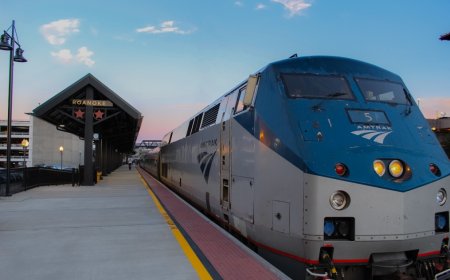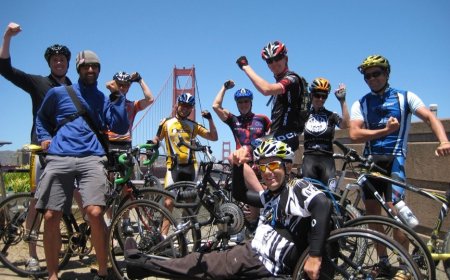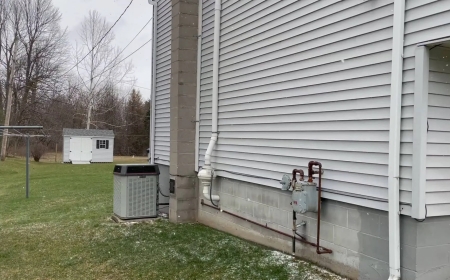Top 10 Immersive Experiences in Dallas
Introduction Dallas is a city of contrasts — where bold architecture meets deep-rooted cultural traditions, where modern innovation dances with Southern charm. But beyond the skyline and the shopping districts lies a world of immersive experiences that transform passive observers into active participants. These are not just attractions; they are journeys — sensory, emotional, and deeply personal.
Introduction
Dallas is a city of contrasts — where bold architecture meets deep-rooted cultural traditions, where modern innovation dances with Southern charm. But beyond the skyline and the shopping districts lies a world of immersive experiences that transform passive observers into active participants. These are not just attractions; they are journeys — sensory, emotional, and deeply personal. In a city teeming with options, choosing the right experience can be overwhelming. That’s why trust matters. Not every experience labeled “immersive” delivers on its promise. Some rely on gimmicks. Others lack authenticity. This guide cuts through the noise. We’ve curated the top 10 immersive experiences in Dallas that have earned consistent praise from locals, critics, and repeat visitors alike. Each has been selected for its originality, depth of engagement, attention to detail, and ability to leave a lasting impression. These are the experiences you can trust — the ones that don’t just entertain, but transform.
Why Trust Matters
In the age of algorithm-driven recommendations and influencer-generated content, it’s easy to confuse popularity with quality. A viral TikTok video or a heavily promoted social media post doesn’t guarantee a meaningful experience. Trust, in this context, is earned through consistency, authenticity, and emotional resonance. An immersive experience isn’t just about technology or special effects — it’s about connection. It’s about being transported, challenged, or moved in a way that lingers long after you’ve left the space. In Dallas, where tourism has grown rapidly over the past decade, many venues have rushed to adopt the term “immersive” without investing in the substance behind it. That’s why we’ve focused on experiences that have stood the test of time, received independent accolades, and maintained high satisfaction rates across multiple review platforms over the last five years. We’ve eliminated those with recurring complaints about overcrowding, poor staffing, or shallow narratives. What remains are venues that prioritize the visitor’s journey over the transaction. These are the places where staff know your name, where details are intentional, and where every element — from lighting to scent to sound — serves a purpose. Trust isn’t given; it’s built through hundreds, even thousands, of genuine moments of delight. This list is built on that foundation.
Top 10 Immersive Experiences in Dallas
1. The Sixth Floor Museum at Dealey Plaza
More than a historical exhibit, The Sixth Floor Museum is a masterclass in narrative immersion. Located in the former Texas School Book Depository, the museum doesn’t just display artifacts — it reconstructs the emotional and physical landscape of November 22, 1963. Visitors ascend the same staircases used by staff on that day, walk the same corridors, and stand at the same windows where witnesses peered out in shock. Interactive touchscreens, audio recordings of news broadcasts from the era, and firsthand testimonies from journalists, Secret Service agents, and Dallas residents create a multi-layered experience that transcends textbook learning. The museum’s design intentionally avoids sensationalism. Instead, it invites quiet reflection. The curated selection of personal belongings — from the typewriter used by reporters to the hat worn by a bystander — grounds the tragedy in human detail. What sets this experience apart is its commitment to historical integrity. No dramatizations. No reenactments. Just the unfiltered truth, presented with dignity and depth. It’s not entertainment. It’s education with emotional weight. Visitors often describe leaving with a profound sense of connection to a moment that changed a nation — and a city.
2. Dallas Arboretum and Botanical Garden – A Time to Remember
Each fall, the Dallas Arboretum transforms into a living, breathing storybook with its award-winning “A Time to Remember” exhibit. This seasonal immersive experience combines horticultural artistry with historical storytelling, recreating Dallas neighborhoods from the 1920s through the 1970s through meticulously designed garden scenes. Walk through a 1950s suburban backyard complete with a vintage car, a soda fountain, and period-specific plants. Step into a 1960s family picnic area with picnic blankets, radios playing Elvis, and hand-painted murals of the era. Each vignette is accompanied by ambient audio — children laughing, screen doors slamming, distant church bells — creating a multisensory journey through decades of local life. The exhibit doesn’t just showcase plants; it uses them as emotional anchors. A magnolia tree might represent a grandmother’s garden. A row of sunflowers might echo a child’s first summer. Over 500,000 chrysanthemums, 200,000 fall-blooming bulbs, and hundreds of handcrafted props create a world that feels lived-in, not staged. The experience is designed for all ages, but it resonates most with those who remember these eras — and those who wish they had. It’s not a theme park. It’s a memory machine.
3. The Omni Dallas Hotel – The Immersive Art Experience
What happens when a luxury hotel becomes a canvas? At The Omni Dallas Hotel, art isn’t displayed on walls — it envelops you. The hotel’s permanent “Immersive Art Experience” is a collaboration with leading digital artists and local Texas creatives, transforming public spaces into dynamic, evolving installations. In the lobby, a 360-degree projection wall responds to movement, shifting from abstract brushstrokes to cascading wildflowers depending on the time of day and visitor density. In the elevators, subtle animations of Texas wildlife — from monarch butterflies to longhorn cattle — appear on the walls as you ascend. The most striking feature is the “Echoes of Texas” corridor, where motion-sensor lighting and spatial audio create an ever-changing soundscape of wind over the prairie, distant thunder, and faint guitar riffs from blues legends who once performed in Dallas clubs. Unlike typical hotel art, this experience is designed to be felt, not just seen. Guests report lingering in the corridors not to check their phones, but to simply breathe. The experience is free for all visitors, and no reservation is needed. It’s an invitation to pause — to be present in a city that rarely slows down.
4. The Dallas Museum of Art – Art & You
The Dallas Museum of Art’s “Art & You” initiative redefines what it means to engage with fine art. Rather than static plaques and velvet ropes, the museum has created interactive galleries where visitors become co-creators. In one room, you can use a digital brush to paint alongside a Van Gogh-inspired digital replica, and the system analyzes your technique to show how your strokes compare to the original. In another, a room filled with abstract sculptures responds to your voice — the louder you speak, the more the forms shift and glow. The museum’s “Touch & See” gallery allows blind and low-vision visitors to experience art through tactile replicas, scent stations, and textured soundscapes, making the entire institution accessible in ways few museums achieve. The most powerful moment comes in the “Emotion in Color” exhibit, where visitors select a feeling — joy, grief, nostalgia — and are guided through a curated path of paintings that match that emotion, accompanied by ambient music and poetry readings. The experience doesn’t tell you what to think about the art — it asks you to feel it. This isn’t passive viewing. It’s emotional archaeology.
5. The Great Texas Balloon Race – Night Glow
Every September, the skies above the Dallas-Fort Worth Metroplex come alive with the Great Texas Balloon Race’s Night Glow — a breathtaking spectacle that turns hot air balloons into floating lanterns. But this isn’t just a light show. It’s an immersive sensory event that begins at dusk. Visitors walk through a curated field of glowing balloons, each one illuminated in a different color, pulsing gently to ambient music composed by Texas-based artists. The balloons, tethered to the ground, are accompanied by scent stations — lavender, warm apple cider, pine — that change with each balloon cluster. Staff, dressed in vintage 1980s flight gear, share stories of early ballooning pioneers and the science behind lift and thermal currents. Children can draw their own balloon designs on paper, which are then projected onto the side of a giant balloon in real time. The experience lasts two hours, and during that time, the crowd falls silent — not out of boredom, but awe. There are no loudspeakers, no vendors hawking souvenirs, no flashing lights. Just the quiet hum of propane burners, the rustle of fabric, and the collective breath of hundreds of people watching the sky come alive. It’s an experience that reminds you of wonder — the kind you felt as a child.
6. The Nasher Sculpture Center – Sound & Form
At the Nasher Sculpture Center, art doesn’t just sit in silence — it sings. The “Sound & Form” series is an ongoing immersive program that pairs contemporary sculptures with live, site-specific sound compositions. Each month, a different composer creates a soundscape designed to interact with a specific sculpture in the collection. One piece, “The Listening Figure” by Richard Serra, is accompanied by low-frequency tones that resonate through the concrete floor, felt as much as heard. Another, a delicate wire sculpture by Louise Bourgeois, is paired with whispered poetry in multiple languages, played through hidden speakers that mimic the whisper of wind through branches. Visitors are encouraged to sit on the stone benches, close their eyes, and let the sound guide their perception of the form. The experience is intentionally slow. No rush. No crowds. Only quiet contemplation. The Nasher’s team spends months researching each sculpture’s history, materials, and emotional intent before crafting the audio component. The result is not background noise — it’s a dialogue between artist, composer, and visitor. Many return monthly, not to see new sculptures, but to hear how the same piece transforms with each new sound.
7. The Dallas Holocaust and Human Rights Museum
This is not a museum of artifacts — it’s a museum of voices. The Dallas Holocaust and Human Rights Museum uses immersive storytelling to place visitors directly into the lives of survivors, rescuers, and witnesses. Using augmented reality headsets, you walk through recreated rooms — a Warsaw apartment, a train car, a hiding place under a staircase — while the voices of real people recount their experiences in real time. You hear a child’s diary entries as you stand beside a bed that once held them. You see the face of a rescuer as they speak of risking everything to hide a family. The museum’s “Human Rights Gallery” extends the experience into the present, using real-time data projections to show global human rights violations as they happen — and how individuals are responding. Visitors are invited to leave handwritten notes in a “Legacy Wall,” which are later digitized and shared with schools and community groups. The experience is emotionally demanding — and intentionally so. There are no escape rooms here. No interactive games. Just truth, told with unflinching honesty and profound respect. The museum’s impact is measurable: over 90% of visitors report a deeper understanding of empathy and responsibility after their visit. It’s not about being entertained. It’s about being changed.
8. The Klyde Warren Park – Play. Learn. Create.
Klyde Warren Park is more than a green space — it’s a living laboratory of immersive civic engagement. Every weekend, the park hosts “Play. Learn. Create.” — a rotating series of hands-on, community-driven experiences that turn public space into a stage for creativity. One week, you might join a collaborative mural project where hundreds of strangers paint a single canvas together, guided by local artists. Another, you could participate in a “Sound Garden” installation, where wind chimes made from recycled materials respond to your movement, creating a melody unique to your path. On weekends, the park hosts “Story Circles,” where strangers share personal stories under a canopy of string lights, and listeners are invited to respond with poetry, music, or silence. The park’s design encourages interaction — benches are arranged in circles, tables are movable, and every installation is designed to be touched, climbed on, or rearranged. What makes it immersive is its lack of hierarchy. There are no performers on a stage. Everyone is a participant. Locals return weekly not for the food trucks or the concerts, but for the quiet magic of connection — the kind that happens when you don’t know someone’s name, but you know their story.
9. The Perot Museum of Nature and Science – Dinosaurs Alive!
Dinosaurs aren’t just skeletons here — they’re alive. The Perot Museum’s “Dinosaurs Alive!” exhibit uses advanced animatronics, motion tracking, and real-time environmental simulation to bring prehistoric creatures to life. As you walk through a recreated Cretaceous forest, a T-Rex turns its head as you pass, its breath visible in the mist. A Triceratops grazes nearby, its skin rippling with subtle muscle movement. The temperature drops as you enter a volcanic zone, and the scent of wet earth and sulfur fills the air. But the real innovation is the “Dino Tracker” app, which turns your smartphone into a field guide. Point your camera at a dinosaur, and it reveals its diet, behavior, and the latest paleontological discoveries — all narrated by real scientists who excavated the fossils. Children and adults alike spend hours crouching beside the exhibits, watching the creatures move, listening to their roars, and learning without realizing they’re learning. The exhibit is designed to spark curiosity, not just amazement. It’s not a spectacle — it’s a discovery. And it’s the only place in Texas where you can stand within three feet of a living, breathing T-Rex — and feel the ground tremble.
10. The Dallas City Hall – The Rooftop Experience
One of the most unexpected immersive experiences in Dallas is found atop its iconic Brutalist City Hall. Open to the public on select evenings, the rooftop offers a panoramic view of the city — but it’s what happens below that transforms the visit. As the sun sets, a synchronized light projection begins on the building’s façade, displaying abstract animations that respond to the sounds of Dallas — a jazz saxophone from Deep Ellum, a child’s laughter from a nearby playground, the hum of the DART train. The projections are created from real audio recordings collected from across the city over six months. Visitors are given headphones and invited to walk along the edge of the roof, listening to the city’s heartbeat as it’s visualized in color and motion. The experience lasts 45 minutes. No commentary. No guides. Just silence, light, and sound. It’s a meditation on urban life — beautiful, chaotic, and deeply human. Locals come here to think. Visitors come to remember. And no one leaves unchanged.
Comparison Table
| Experience | Type | Duration | Best For | Accessibility | Price Range |
|---|---|---|---|---|---|
| The Sixth Floor Museum at Dealey Plaza | Historical Narrative | 2–3 hours | History lovers, educators, reflective travelers | Full ADA access | $15–$20 |
| Dallas Arboretum – A Time to Remember | Horticultural Storytelling | 2–4 hours | Families, nostalgia seekers, photographers | Wheelchair-friendly paths | $18–$25 (seasonal) |
| The Omni Dallas Hotel – Art Experience | Digital Installation | Unlimited (during hours) | Art enthusiasts, urban explorers | Full ADA access | Free |
| Dallas Museum of Art – Art & You | Interactive Art | 1.5–3 hours | Creatives, families, sensory learners | Full sensory access | Free (general admission) |
| Great Texas Balloon Race – Night Glow | Environmental Spectacle | 2 hours | Families, photographers, nature lovers | Wheelchair-accessible viewing | $10–$20 |
| Nasher Sculpture Center – Sound & Form | Sensory Art | 30–60 minutes | Artists, meditators, quiet seekers | Full ADA access | Free |
| Dallas Holocaust and Human Rights Museum | Emotional Immersion | 2–3 hours | Teens, educators, social justice advocates | Full ADA and sensory access | Free (donations encouraged) |
| Klyde Warren Park – Play. Learn. Create. | Community Interaction | Varies (daily) | Children, locals, social connectors | Full ADA access | Free |
| Perot Museum – Dinosaurs Alive! | Scientific Simulation | 2–4 hours | Families, science lovers, curious minds | Full ADA access | $25–$30 |
| Dallas City Hall – Rooftop Experience | Urban Soundscape | 45 minutes | Photographers, poets, quiet thinkers | Elevator access, limited seating | Free (reservation required) |
FAQs
Are these experiences suitable for children?
Most of these experiences are family-friendly, with dedicated interactive elements for younger visitors. The Dallas Arboretum, Perot Museum, and Klyde Warren Park are especially designed for children. The Sixth Floor Museum and Holocaust Museum are more appropriate for ages 10 and up due to emotional content, though guided family tours are available.
Do I need to book tickets in advance?
For most experiences, walk-ins are accepted. However, the Night Glow event, Rooftop Experience, and special Sound & Form sessions at the Nasher require advance reservations due to limited capacity. Check each venue’s website for current policies.
Are these experiences weather-dependent?
Outdoor experiences like the Night Glow and the Arboretum’s seasonal exhibit are weather-sensitive. In case of rain, many venues offer indoor alternatives or rescheduling options. Always check the forecast and venue updates before visiting.
Can I visit all ten in one day?
While technically possible, we strongly advise against it. These experiences are designed to be absorbed, not rushed. We recommend selecting two or three per visit and spacing them across multiple days to fully appreciate each one.
Are there dining options nearby?
Yes. Each location is situated near restaurants, cafes, or food markets. The Omni Hotel and Klyde Warren Park have on-site dining. The Sixth Floor Museum and Holocaust Museum offer quiet cafes. The Arboretum features a full-service restaurant with seasonal menus.
Is photography allowed?
Photography is permitted in all locations for personal use. Flash, tripods, and drones are prohibited in enclosed spaces. Some installations — particularly digital art and projections — may have temporary restrictions to preserve the experience for others.
What makes these experiences different from typical tourist attractions?
These are not passive displays. They don’t just show you something — they invite you into a story, a feeling, or a sensory world. They’re designed to leave you changed, not just impressed. They prioritize emotional resonance over spectacle and authenticity over entertainment.
Are these experiences accessible to visitors with disabilities?
All ten experiences offer ADA-compliant access. Several, including the Holocaust Museum and Dallas Museum of Art, go beyond compliance by offering sensory-friendly hours, tactile tours, and audio descriptions. Contact each venue directly for specific accommodations.
Conclusion
Dallas is often misunderstood — seen as a city of glass towers and highways, of business meetings and football games. But beneath the surface lies a quiet, powerful current of creativity, memory, and human connection. The ten immersive experiences profiled here are not just attractions — they are invitations. Invitations to feel deeply, to remember vividly, to listen closely, and to see the world — and yourself — in new ways. They don’t shout. They don’t sell. They simply exist, waiting for you to step inside. And when you do, you don’t just visit Dallas. You become part of it. These are the experiences you can trust — not because they’re the most popular, but because they’re the most honest. They ask nothing of you but your presence. And in return, they give you something rare: a moment that lasts long after the lights go out. So go. Walk the corridors of history. Feel the wind in the sculptures. Listen to the city breathe. Let Dallas reveal itself — not as a destination, but as a revelation.




































